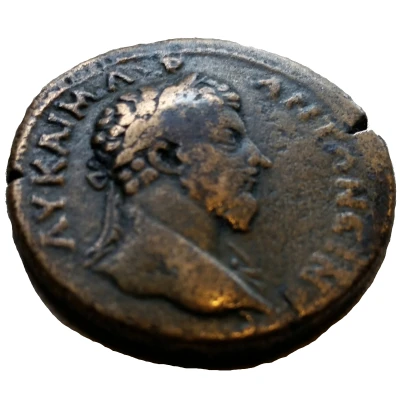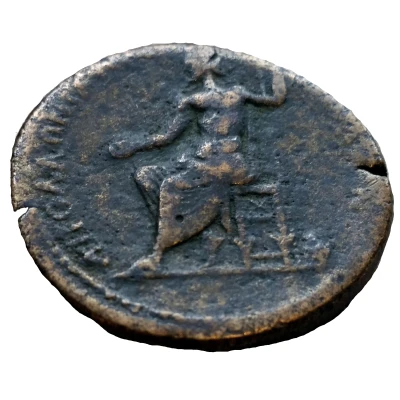


© disha41754 (CC BY)
Æ34 - Marcus Aurelius Zeus seated, Apollonia Mordiaeum, Pisidia
| Bronze | 28 g | 35 mm |
| Issuer | Apollonia Mordiaeum (Galatia) |
|---|---|
| Emperor | Marcus Aurelius (Marcus Aurelius Antoninus) (161-180) |
| Type | Standard circulation coin |
| Years | 161-180 |
| Composition | Bronze |
| Weight | 28 g |
| Diameter | 35 mm |
| Shape | Round (irregular) |
| Technique | Hammered |
| Orientation | Coin alignment ↑↓ |
| Demonetized | Yes |
| Updated | 2024-10-06 |
| Numista | N#82209 |
|---|---|
| Rarity index | 95% |
Reverse
Zeus, seated on throne to left, holding patera in lowered right hand, and sceptre in raised left.
Behind the throne: eagle standing, facing, head, l., spreading wings
Script: Greek
Lettering: ΑΠΟΛΛΩΝΝΙΑΤΩΝ ΛΥΚΙΩΝ
Comment
During the Roman period Pisidia was colonized with veterans of its legions to maintain control. For the colonists, who came from poorer parts of Italy, agriculture must have been the area’s main attraction. Under Augustus, eight such colonies were established in Pisidia, and Antioch and Sagalassos became the most important cities. The province was gradually Latinised. Latin remained the formal language of the area until the end of the 3rd century.Pisidia became an important early Christian centre. Paul the Apostle preached in Antioch on his first journey and visited the area again in his second and third journeys.
https://en.wikipedia.org/wiki/Pisidia#Roman_and_Byzantine_period
Apollonia-Mordiaeum (Oluburlu), near Apameia Cibotus, on the Hippophoras. The title Apolloniatai Lukion Thrakon Kolonoi Απολλονιαται Λυκιον Θρακον Κολονοι, for which the coins vouch, perhaps indicates a settlement of Lycians and Thracians in Apollonia in Imperial times. Quasi-autonomous and Imperial from Titus to Gallienus. Inscr., ΑΠΟΛΛΩΝΙΑΤΩΝ with or without ΛVΚΙΩΝ or ΛV. ΘΡΑ. ΚΟ. Types—Head of Alexander the Great in lion-skin (ΑΛЄΞΑΝΔΡΟC ΚΤΙCΤ.); Apollo leaning on tripod, raven at his feet; Asklepios alone or with Hygieia and Telesphoros; Athena standing; Zeus seated between Mên and Apollo; Sarapis seated between Isis and Harpokrates; Demeter seated holding torches; Triple Hekate; Dionysos; River-god ΙΠΠΟΟΡΑC; Bust of ΒΟVΛΗ; Turreted head of ΑΠΟΛΛΩΝΙΑ; Emperor in temple; &c.
http://www.forumancientcoins.com/numiswiki/view.asp?key=pisidia
Interesting fact
The Marcus Aurelius coin features an image of Zeus seated on one side, which was a common motif on coins during the Roman Empire. However, the other side of the coin features an image of Apollonia Mordiaeum, a city in the Roman province of Galatia, which is now modern-day Turkey. This suggests that the coin may have been minted specifically for use in this region, and could provide insight into the economic and cultural exchange between different parts of the empire during this time period.